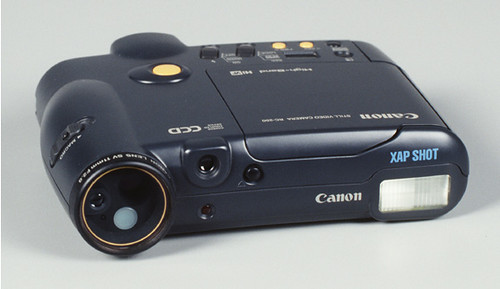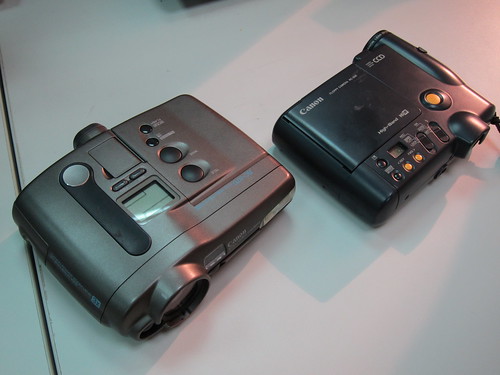Difference between revisions of "Canon RC-250"
m (→Links: better caption) |
(added top rc250 photo) |
||
| Line 1: | Line 1: | ||
{{stub}} | {{stub}} | ||
| − | The binocular-styled '''RC-250''' was a still-video camera introduced by [[Canon]] in December, 1988, after displaying a preproduction version at that year's Photokina show in Cologne, Germany<REF>"The Big Show," December 1988 ''Popular Photography'' (Vol. 95, No. 12; page 94–95).</REF>. Depending on the market, it carried the branding '''Xap Shot''' (US), '''Ion''' (Europe), or '''Q Pic''' (Japan), and was made in both white and black versions. | + | {{Flickr_image |
| + | |image_source= http://www.flickr.com/photos/slackmeister/35529440/in/pool-camerawiki/ | ||
| + | |image= http://farm1.staticflickr.com/24/35529440_51291fd0e3.jpg | ||
| + | |image_align= right | ||
| + | |image_text= | ||
| + | |image_by= JOEGRAPHY | ||
| + | |image_rights= wp | ||
| + | }} | ||
| + | |||
| + | The binocular-styled '''RC-250''' was a still-video camera introduced by [[Canon]] in December, 1988, after displaying a preproduction version at that year's [[Photokina]] show in Cologne, Germany<REF>"The Big Show," December 1988 ''Popular Photography'' (Vol. 95, No. 12; page 94–95).</REF>. Depending on the market, it carried the branding '''Xap Shot''' (US), '''Ion''' (Europe), or '''Q Pic''' (Japan), and was made in both white and black versions. | ||
The camera stores images as analog signals on special compact video floppy disks. The designation "Hi Band" refers to an improved standard for this storage format, potentially resolving 500 video lines (in video terminology, this is the resolution for vertical lines; the number of horizontal scan lines is fixed). However in practice the RC-250 did not attain this, having poorer resolution than the [[Canon RC-470]] which was sold alongside it. | The camera stores images as analog signals on special compact video floppy disks. The designation "Hi Band" refers to an improved standard for this storage format, potentially resolving 500 video lines (in video terminology, this is the resolution for vertical lines; the number of horizontal scan lines is fixed). However in practice the RC-250 did not attain this, having poorer resolution than the [[Canon RC-470]] which was sold alongside it. | ||
Revision as of 04:51, 8 June 2012

|
| image by JOEGRAPHY (Image rights) |
The binocular-styled RC-250 was a still-video camera introduced by Canon in December, 1988, after displaying a preproduction version at that year's Photokina show in Cologne, Germany[1]. Depending on the market, it carried the branding Xap Shot (US), Ion (Europe), or Q Pic (Japan), and was made in both white and black versions.
The camera stores images as analog signals on special compact video floppy disks. The designation "Hi Band" refers to an improved standard for this storage format, potentially resolving 500 video lines (in video terminology, this is the resolution for vertical lines; the number of horizontal scan lines is fixed). However in practice the RC-250 did not attain this, having poorer resolution than the Canon RC-470 which was sold alongside it.
Introduced at a list price of about USD $800, the RC-250 was one of the more successful still-video camera models of the era.
Notes
- ↑ "The Big Show," December 1988 Popular Photography (Vol. 95, No. 12; page 94–95).
Links
- Canon RC-250 at the Canon Camera Museum
- Canon Camera Story, 1987–1991 at Canon Camera Museum history hall

|
| Comparison of RC-250 (right) to 1992 Canon RC-570 image by 柳丁皮蒙面俠 (Image rights) |